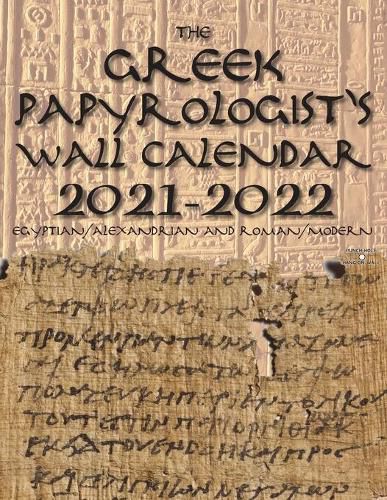Readings Newsletter
Become a Readings Member to make your shopping experience even easier.
Sign in or sign up for free!
You’re not far away from qualifying for FREE standard shipping within Australia
You’ve qualified for FREE standard shipping within Australia
The cart is loading…






This title is printed to order. This book may have been self-published. If so, we cannot guarantee the quality of the content. In the main most books will have gone through the editing process however some may not. We therefore suggest that you be aware of this before ordering this book. If in doubt check either the author or publisher’s details as we are unable to accept any returns unless they are faulty. Please contact us if you have any questions.
The Greek Papyrologist’s Wall Calendar is designed for those students and scholars of ancient Greek papyri who want to become more familiar with the ancient calendar in use by the authors and recipients of the texts they are reading. One of the challenges in designing such a resource, however, comes in the desire to both authentically represent an ancient calendar and present it in such a way that makes it practical for the modern user. The Greek Papyrologist’s Calendar thus achieves something of a compromise by laying out the ancient Egyptian/Alexandrian calendar in a modern wall-calendar format coordinated with Roman/modern dates so that a modern student or scholar can practically use the ancient calendar in their daily life with modern dates.
Although there were numerous calendars in use in antiquity that are attested in the papyri (Egyptian, Macedonian, Greek, Roman, etc.), the Egyptian calendar was chosen for The Greek Papyrologist’s Wall Calendar because Egypt plays such a central role in the field of papyrology and the Egyptian calendar is prominent in the papyrological material. The Egyptian calendar is made up of 12 months of 30 days with 5 intercalary days (
) at the end of each year.The format of the calendar is as follows: Each upper page of a month in the calendar lists the name of the Egyptian/Alexandrian month in Greek at the top along with some facts about the month including ancient Egyptian festivals. Each lower page of the calendar presents the ancient calendars in modern format, with Egyptian/Alexandrian dates listed in blue and Roman/modern dates listed in red. Each day is written as a Greek numeral along with how the day would have been referred to in ancient times (in Greek), whether simply the twenty-first of Thoth or six before the Ides of March .
By using this system, the student or scholar will be able to see both how the date would have likely been written in the papyri and how a Greek speaker would have referred to the day of the month, whether in the Egyptian or Roman system.
$9.00 standard shipping within Australia
FREE standard shipping within Australia for orders over $100.00
Express & International shipping calculated at checkout
This title is printed to order. This book may have been self-published. If so, we cannot guarantee the quality of the content. In the main most books will have gone through the editing process however some may not. We therefore suggest that you be aware of this before ordering this book. If in doubt check either the author or publisher’s details as we are unable to accept any returns unless they are faulty. Please contact us if you have any questions.
The Greek Papyrologist’s Wall Calendar is designed for those students and scholars of ancient Greek papyri who want to become more familiar with the ancient calendar in use by the authors and recipients of the texts they are reading. One of the challenges in designing such a resource, however, comes in the desire to both authentically represent an ancient calendar and present it in such a way that makes it practical for the modern user. The Greek Papyrologist’s Calendar thus achieves something of a compromise by laying out the ancient Egyptian/Alexandrian calendar in a modern wall-calendar format coordinated with Roman/modern dates so that a modern student or scholar can practically use the ancient calendar in their daily life with modern dates.
Although there were numerous calendars in use in antiquity that are attested in the papyri (Egyptian, Macedonian, Greek, Roman, etc.), the Egyptian calendar was chosen for The Greek Papyrologist’s Wall Calendar because Egypt plays such a central role in the field of papyrology and the Egyptian calendar is prominent in the papyrological material. The Egyptian calendar is made up of 12 months of 30 days with 5 intercalary days (
) at the end of each year.The format of the calendar is as follows: Each upper page of a month in the calendar lists the name of the Egyptian/Alexandrian month in Greek at the top along with some facts about the month including ancient Egyptian festivals. Each lower page of the calendar presents the ancient calendars in modern format, with Egyptian/Alexandrian dates listed in blue and Roman/modern dates listed in red. Each day is written as a Greek numeral along with how the day would have been referred to in ancient times (in Greek), whether simply the twenty-first of Thoth or six before the Ides of March .
By using this system, the student or scholar will be able to see both how the date would have likely been written in the papyri and how a Greek speaker would have referred to the day of the month, whether in the Egyptian or Roman system.